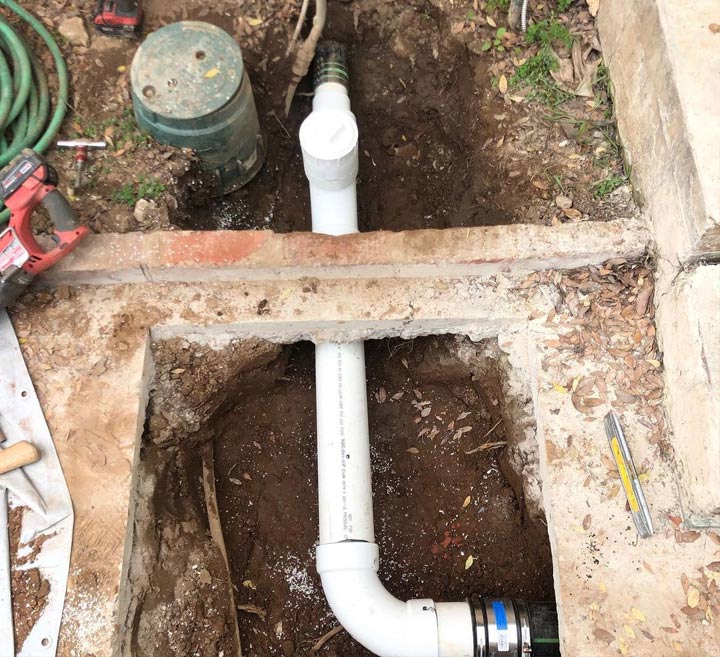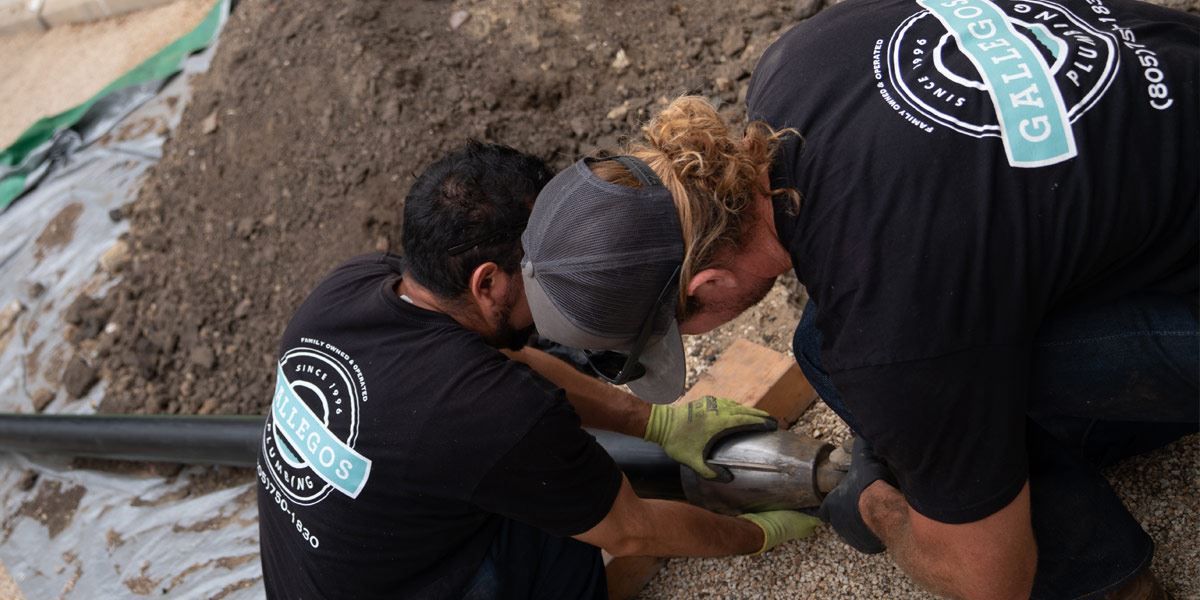The term ‘sewer line bellies‘ refers to a sag or low spot that can develop in a sewer pipe. Typically, a lateral sewer line is installed at a slight slope to rely on gravity to move the waste through the pipe. However, when a sewer line belly develops, the sag can cause backups and sediment collection to occur in the space. Proper sewer line repair can fix the problem if carried out by a plumbing professional.
Sewer line repair Professionals such as Gallegos Plumbing can assist you in plumbing inspection and keep your sewer line system in proper condition.
Table of Contents
- Sewer Belly Causes
- Preventing Sewer Bellies
- Sewer Belly Diagnosis
- Misdiagnosis: Sewer Channeling
- Repairing Sewer Belly Pipe Problems
» Sewer Belly Causes
A variety of things can cause a sewer line belly to develop. Typically, bad installation and poor planning on the leading causes. During installation, bedding compassion, correct slope, and materials work to prevent the problem. In addition, other factors can lead to a sewer belly, such as a development of tree roots, excessive sun and heat baking the pipe, cold fluctuations, rain exposure, earthquakes, and shifts in the soil.
» Preventing Sewer Bellies

One of the first steps to undertake to prevent a sewer belly from developing is to ensure that you install property bedding. Large grade gravel and sand are ideal when packed around the pipe. Please remember, if you do not use the proper material, then the pipe will start to settle into the ground forming a sag or ‘sewer belly.’
The slope is another factor. The sewer line also needs to be installed with the correct slope to correctly use gravity, pushing the waste from the home or building. Professionals usually use a combination of tools such as locator wands and video cameras to make sure the slope is correct so an excessive build-up of waste does not occur within the pipe.
The unstable ground often leads to sewer bellies. Even when installed with the proper support, the pipe might sag if the earth undergoes natural geographic shifting.
» Sewer Belly Diagnosis
If you suspect that your building or home has a sewer belly, then you’ll want to contact a professional plumber to diagnose the problem. Plumbers rely on the most modern technology, such as a detailed sewer pipe inspection which involves thrusting a video camera directly through the sewer line pipe to take a close look at the later expanse and identify the issue. With the camera, they can figure out if there is any slope issue causing the backup.
Also Read: How to Decide Whether Your Sewer Line Needs Repair or Replacement
» Misdiagnosis: Sewer Channeling
On occasion, a misdiagnosis can occur. Sometimes a sewer belly is sewer channeling. Channeling refers to the buckling of a sewer pipe. Erosion starts to occur, and the earth starts to shift, which causes the pipe to develop buckles. Sewer pipe buckles obstruct the flow of the water and cause a blockage to form. Usually, A camera will diagnose sewer channeling.
Channeling does often occur, especially with sewer lines referred to as Orangeburg. The Orangeburg pipes’ popularity span from 1945 to 1972. The material used in the pipe construction was referred to as tar paper, and it can often buckle as the pipe ages. Usually, an Orangeburg sewer pipe will last thirty years before it starts to decay and flatten, which causes a channel to develop. Orangeburg pipes were relatively standard in the eastern states and are exceedingly rare in the western. Typically cast iron, plastic, and clay sewer pipes were used in the western states.
Also Read: Sewer Line Repair: Debating the Two Methods – Is One Better Than the Other?
» Repairing Sewer Belly Pipe Problems
There are a variety of ways to repair a sewer belly pipe problem. A trenchless sewer repair method is an ideal solution. The plumbing company will use an open trench to build and fill the void that sits beneath the sagging sewer pipeline with dirt and gravel. After filling the void, the plumbing experts will further strengthen and reinforce all the pipe’s joints. Once the sewer belly has undergone a trenchless sewer pipe repair, proper material is placed around the pipe to reinforce things further.

Another repair possibility for sewer belly pipe problems is a trenchless pipe lining (CIPP), a slip lining. However, the repair method is challenging because of allowing. It is difficult, if not impossible, to obtain the correct permitting to repair. The permitting difficulty is that toxic chemicals that are harmful to the area’s water system and groundwater are used during the repair process. However, CIPP can extend the life of the existing sewer lateral. This method is rarely successful if the pipe has eroded.
If you suspect that you have a sewer belly, please contact plumbing professionals at Gallegos plumbing or call us now at (805) 243-2622 for a complete sewer line repair (when needed, we carry out trenchless sewer repair). Our experts will diagnose the problem and then discuss your repair or replacement options.
Also Read: Before You Hire the Sewer Repair Contractor – Follow These 5 Recommendations
» Sewer Belly Causes
A variety of things can cause a sewer line belly to develop. Typically, bad installation and poor planning on the leading causes. During installation, bedding compassion, correct slope, and materials work to prevent the problem. In addition, other factors can lead to a sewer belly, such as a development of tree roots, excessive sun and heat baking the pipe, cold fluctuations, rain exposure, earthquakes, and shifts in the soil.
» Preventing Sewer Bellies
One of the first steps to undertake to prevent a sewer belly from developing is to ensure that you install property bedding. Large grade gravel and sand are ideal when packed around the pipe. Please remember, if you do not use the proper material, then the pipe will start to settle into the ground forming a sag or ‘sewer belly.’
The slope is another factor. The sewer line also needs to be installed with the correct slope to correctly use gravity, pushing the waste from the home or building. Professionals usually use a combination of tools such as locator wands and video cameras to make sure the slope is correct so an excessive build-up of waste does not occur within the pipe.
The unstable ground often leads to sewer bellies. Even when installed with the proper support, the pipe might sag if the earth undergoes natural geographic shifting.
» Sewer Belly Diagnosis
If you suspect that your building or home has a sewer belly, then you’ll want to contact a professional plumber to diagnose the problem. Plumbers rely on the most modern technology, such as a detailed sewer pipe inspection which involves thrusting a video camera directly through the sewer line pipe to take a close look at the later expanse and identify the issue. With the camera, they can figure out if there is any slope issue causing the backup.
Also Read: How to Decide Whether Your Sewer Line Needs Repair or Replacement
» Misdiagnosis: Sewer Channeling
On occasion, a misdiagnosis can occur. Sometimes a sewer belly is sewer channeling. Channeling refers to the buckling of a sewer pipe. Erosion starts to occur, and the earth starts to shift, which causes the pipe to develop buckles. Sewer pipe buckles obstruct the flow of the water and cause a blockage to form. Usually, A camera will diagnose sewer channeling.
Channeling does often occur, especially with sewer lines referred to as Orangeburg. The Orangeburg pipes’ popularity span from 1945 to 1972. The material used in the pipe construction was referred to as tar paper, and it can often buckle as the pipe ages. Usually, an Orangeburg sewer pipe will last thirty years before it starts to decay and flatten, which causes a channel to develop. Orangeburg pipes were relatively standard in the eastern states and are exceedingly rare in the western. Typically cast iron, plastic, and clay sewer pipes were used in the western states.

